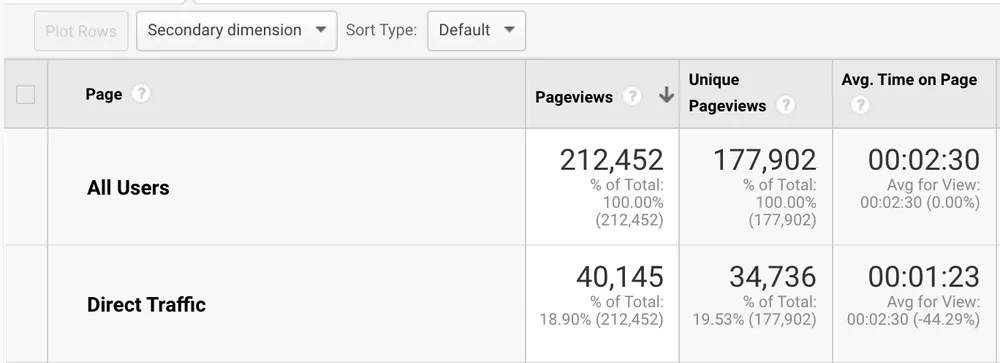Direct traffic has an exciting name. Direct! It’s traffic that comes straight to you!
But in Google Analytics, the Direct Traffic label is often a way of saying, “We don’t really know where this traffic is coming from.”
If more than ~20% of your traffic is categorized as Direct, then your overall data analysis is probably suffering. You can fix that.

🧩 What is Direct Traffic?
The answer to this question has two parts.
First, there is real direct traffic: people typing your URL directly into their address bar. (This is good – it means that your brand team is doing its job!)
Additionally, there’s unidentified traffic from any number of sources (email, social, paid ads, etc.) that Google Analytics is lumping in there too, under the Direct Traffic label.
Why? (This is where it gets technical.) Because the links from those sources don’t have any referrer information.
For example: if the same ercule.co/smoothjazz link is in my Twitter profile and my email signature, there’s no way to tell which clicks came through Twitter and which ones came through email. GA reads them both as having no referrer – the same as typing that URL into an address bar.
🍋 Common causes of Direct Traffic bloat
Some can be remedied on the front end:
- Email, especially prospecting email from your sellers. If you send a lot of email, or if your sellers do, that can mean a lot of direct traffic.
- Traffic from social apps. When you link from an app like Instagram to a website, referrer information is generally not sent.
Others are structural and require more back-end attention:
- Inconsistent Google Analytics implementation. If Google Analytics is on some pages on your site, but not others, a visitor who goes from an untagged page to a tagged page will show up as direct (because the referrer will be your own site!)
- Insecure sites. Your site should be serving in https, for lots of reasons. If it isn’t, you may also see additional direct traffic, as document referrers generally aren’t sent from https to http sites.
🏄🏼 What you can do to improve Direct Traffic data
One surefire way to improve your data: make sure every link you send has a utm_medium parameter.
For example, in a sales email… Let’s say you’ve been including a product demo link: yoursite.com/demo
When a lead clicks on the link, it counts as direct traffic. Instead, you can include a UTM parameter: yoursite.com/demo?utm_medium=email
You should also use utm_source in links as well. If this sales email was triggered by a webinar invite, that source can be added: yoursite.com/demo?utm_medium=email&utm_source=webinar_invite
You can add UTM parameters to most channels: ads, links on social, referral programs, etc.
This isn’t a silver bullet for all direct traffic issues. If Google Analytics implementation is inconsistent, for example, it requires different solutions. (We recommend looking up suspect pages in GA and seeing if they show).
But UTMs will decrease overall Direct Traffic volume – and give you better data about your key channels right away.
Feel free to schedule office hours to look at this together!
